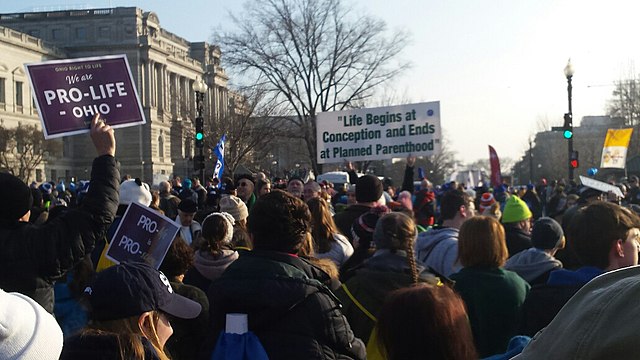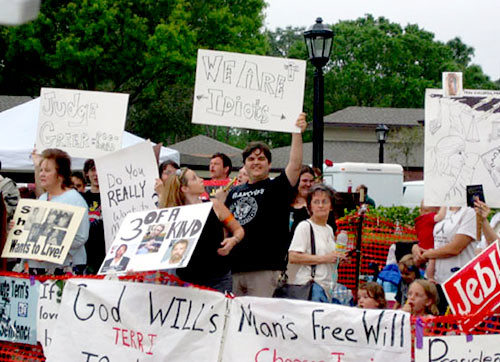


Colorado Outlaws Medical-Abortion Reversal

How Assisted Suicide Advocacy Overturned Roe v. Wade
Back in the 1990s, noting the success of abortion rights advocacy in the federal courts, the assisted-suicide movement moved to circumvent the democratic process by convincing the United States Supreme Court to impose an assisted suicide Roe v. Wade: a decision that would establish doctor-prescribed or administered death as a national constitutional right. The assisted suicide advocates succeeded in obtaining two Supreme Court hearings. However, in a delicious irony, not only did their cases fail abysmally, but the precedent the Supreme Court established in one of the cases would years later become the hammer that shattered the constitutional right to abortion. The Attempt to Declare Washington’s Law Banning Assisted Suicide Unconstitutional In 1994, the assisted suicide advocacy group Compassion in Dying (now merged with the Hemlock Society to become Compassion and Choices) joined with three dying patients and five physicians to challenge Washington’s then-existing law that criminalized assisted suicide. The record prior to reaching the high court was mixed: The plaintiffs had won in the trial court, then lost in the U.S. Court of Appeals for the Ninth Circuit, where a threejudge panel ruled that Washington’s law was constitutional. Then, the notoriously liberal Ninth Circuit granted an en banc hearing by 11 judges, which (in an eight-to-three decision) found that Washington’s law against assisted suicide was indeed unconstitutional. Although it never became law, the decision of the en banc court, written by Chief Judge Stephen Reinhardt, is worth pondering because it illustrates the true pro-euthanasia mindset and broad agenda of the euthanasia movement. First, the majority quickly and hubristically dismissed the court’s obligation to apply the law as written and to depend on previous rulings: “We must strive to resist the natural judicial impulse to limit our vision to that which can plainly be observed on the face of the document before us, or even that which we have previously had the wisdom to recognize.” Thus freeing themselves of the usual constraints that serve to limit the scope of judicial rulings, Reinhardt and seven of his colleagues in effect licensed themselves to create new constitutional rights out of whole cloth: The wording of the United States Constitution, the binding nature of judicial precedent, and even the vote of the people of Washington only five years earlier rejecting legalization of assisted suicide carried no weight. (By 2008, voters had changed their minds about the issue and legalized assisted suicide for the terminally ill in Initiative 1000.) The Compassion in Dying ruling relied on opinion polls for justification; it blurred sensitive and vital distinctions and was rife with factual error. For example, the eleven-judge panel found: “Unlike the depressed twenty-oneyear-old, the romantically devastated twenty-eight-year-old, the alcoholic forty-year-old . . . who may be inclined to commit suicide, a terminally ill, competent adult cannot be cured.” Yet, there are many cases of people diagnosed as near death who live for many years. Judge Reinhardt also wrote: “While some people who contemplate suicide can be restored to a state of physical and mental well-being, terminally ill adults who wish to die can only be maintained in a debilitated and deteriorating state, unable to enjoy the presence of family or friends.” But that is both alarmist and a false paradigm. Medical science has tremendous abilities to palliate the symptoms associated with the end of life. I witnessed such beneficence with my own parents, who both died naturally under the compassionate care of hospice professionals. But factual inaccuracies were a minor problem compared to the rest of Judge Reinhardt’s decision. Officially, the case stood for the (now defunct) proposition that there is a fundamental liberty interest in the United States Constitution in allowing citizens a “right to die.” Unlike other constitutional rights, however, this “liberty interest” would not have been available to all people. Rather, deciding who did or did not possess it would have involved a sliding scale—with some lives deserving of greater protection by the state than others. According to Reinhardt, the state had the highest interest in protecting the lives of the “young and healthy” from suicide, but not much interest in protecting those “who are diagnosed as terminally ill” from suicide. So long as the dying were not coerced into choosing death and were mentally competent (both extremely questionable propositions), Reinhardt and his seven majority-opinion colleagues would have granted them an almost absolute right to choose to be assisted in their suicide by a doctor. Judge Reinhardt’s decision would also have opened the door to hastening the deaths of people with disabilities: There are . . . subtle concerns . . . advanced by some representatives of the physically impaired, including the fear that certain physical disabilities will erroneously be deemed to make life “valueless.” While we recognize the legitimacy of these concerns, however, we also recognize that seriously impaired individuals will, along with nonimpaired individuals, be the beneficiaries of the liberty interest asserted here—and that if they are not afforded the option to control their own fate, they like many others will be compelled against their will to endure protracted suffering. Judge Reinhardt even legitimized money worries as a reason for seeking medicalized suicide: While state regulations can help ensure that patients do not make uninformed, or ill-considered decisions, we are reluctant to say that, in a society in which the costs of protracted health care can be so exorbitant, it is improper for competent, terminally ill adults to take the economic welfare of their families and loved ones into consideration. Not only that, but Judge Reinhardt’s decision would have allowed active euthanasia: We recognize that in some instances, the patient may be unable to self-administer the drugs and that administration by a physician, or a person acting under his direction or control, may be the only way the patient may receive them. He also endorsed nonvoluntary killings of the incompetent—which, by definition, includes children, who generally are not allowed to make their own healthcare decisions—by allowing surrogates to choose death for their wards: “We should make it clear that a decision [to end a patient’s life] of Read More ›

Dutch Expand Euthanasia to Children Ages One to Twelve
Because of course they do. Once euthanasia is accepted by a society, it is a one-way street, continually expanding the killable castes. The Dutch already allowed euthanasia for ages twelve and up. Now, it is down to age one. From the NTD News story: The Netherlands has said it will broaden its euthanasia regulations to allow doctors the ability to end the lives of terminally ill children between one and 12 years old. The rule change involves the government adjusting an existing protocol, and does not require parliamentary approval. The decision comes after years of requests from some Dutch doctors to lower the age limit of 12 for euthanasia, as well as debate within the cabinet. According to the Dutch government, “The end of life for this [age] group is the only reasonable alternative to the child’s unbearable and hopeless suffering.” That’s always the excuse. But Dutch MDs kill babies born with terminal or seriously disabling conditions already under the Groningen Protocol. Given that Dutch doctors euthanize many people — including elderly couples, young women with anorexia, the disabled, and people with mental illnesses — the notion that euthanasia will be “strictly” limited to children close to death whose suffering cannot otherwise be ameliorated is bitterly laughable on its face.

California Bill to Exclude Parents from Children’s Mental-Health Care
![Historic Tower at Walter Reed National Military Medical Center - Bethesda, Maryland [Washington, DC Metropolitan Area - USA]](https://humanize.today/wp-content/uploads/sites/5/2023/04/historic-tower-at-walter-reed-national-military-medical-center-bethesda-maryland-washington-dc-metropolitan-area-usa-stockpack-adobe-stock-2400x1600.jpg)
Did Walter Reed Hospital Neglect Faith Needs of Catholic Patients?

Todd Myers on Democratizing Environmentalism by ‘Thinking Small’
The environmental movement is growing ever-more extreme. Radical ideas such as granting rights to nature—including geological features like rivers, lakes, and glaciers—are gaining popularity as a means of “saving the planet.” But is there another way? Can we fulfill our human duty to be good stewards of the environment without undermining human exceptionalism and impeding our thriving? According to my guest Todd Myers, the answer is definitely, yes. In his interesting new book, Time to Think Small, Myers writes that “nimble environmental technologies can help solve the planet’s biggest problems.” Through the power of smart phones, Myers argues, coupled with the ingenuity of software apps, we can all help promote a healthy environment through millions of individual actions—and without sacrificing freedom or harming the economy. Myers is a former member of the Washington State Department of Natural Resources, and a member of the Puget Sound Salmon Recovery Council. He currently serves as the environmental director at the Washington Policy Center, a public policy think tank in Seattle. His writing has appeared in the Wall Street Journal, National Review, Seattle Times, and USAToday. He has been interviewed on numerous news network programs, including on CNN, CNBC, and Fox News. Myers has a Master’s Degree in Russian/International Studies from the University of Washington. He lives in the Cascade Mountains in Washington with his wife and 200,000 honeybees. Amazon.com: Time to Think Small: How Nimble Environmental Technologies Can Solve the Planet’s Biggest Problems: 9781623545543: Myers, Todd: Books Center for the Environment » Centers » Washington Policy Center Climate action is in our hands with tech that encourages small steps https://www.seattletimes.com/opinion/climate-action-is-in-our-hands-with-tech-that-encourages-small-steps/ There’s A New Book The Climate Industrial Complex Doesn’t Want You To Read https://dailycaller.com/2022/11/13/opinion-theres-a-new-book-the-climate-industrial-complex-doesnt-want-you-to-read-bastasch/ Small Technologies: The Millions Interviews Todd Myers https://themillions.com/2022/10/small-technologies-the-millions-interviews-todd-myers.html New Congress Should Empower People — Not Politicians — for Environmental Results https://www.realclearpolicy.com/articles/2022/11/15/new_congress_should_empower_people__not_politicians__for_environmental_results_864934.html

Transhumanists’ Futile Quest for Eternal Life

UN-Sponsored Report Would Destroy Communities by Gutting Criminal Law
